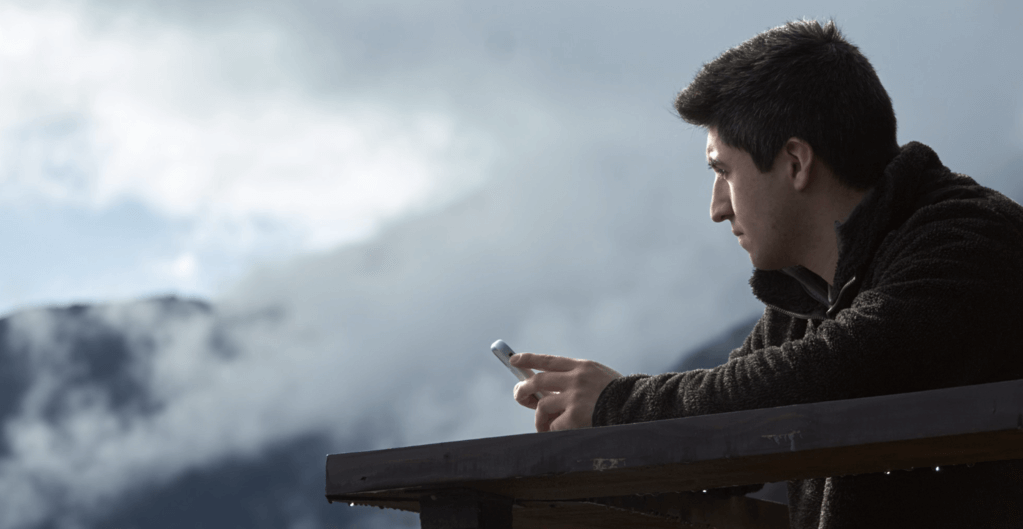In today’s hyperconnected world, the traditional notion of solitude has undergone a profound transformation. As we scroll through social media feeds, check notifications, reply to messages and engage with digital content, we exist in a paradoxical state: physically alone yet constantly connected to others. As our digital connections proliferate, many people report feeling increasingly isolated in what has become known as a loneliness epidemic.
The boundary between being physically alone and being alone with one’s thoughts has become porous, creating new states of “connected solitude” that put traditional notions of private reflection in check. Thanks to the omnipresence of smartphones and the multiple channels of communication they provide, solitude can no longer be defined merely by physical separation. University of Michigan researcher Scott Campbell suggests we rethink solitude as “noncommunication” rather than physical aloneness.
The ubiquity of smart devices connected to the internet has fundamentally altered our experience of privacy, personal space, social connection, and mental well-being in ways we are only beginning to understand. These shifts have very real implications. Back in 2018, psychiatry professor Dr. Elias Aboujaoude went as far as saying protecting privacy is an ethical imperative to safeguard mental health.
How we got here: Solitude and privacy
Solitude has traditionally been defined by physical separation from others. Ancient Greek philosophers like Aristotle distinguished between public spheres (polis) and private life. They saw the public realm as a space of freedom where individuals could actualize their potential as citizens while distancing themselves from private concerns.
Historically, physical solitude was often a luxury. Medieval homes offered virtually no privacy, with families, servants, and guests often living together in small spaces. Only monks, scholars, and the wealthy were entitled to solitude. The evolution of Western architecture over centuries gradually created homes that enabled personal retreat, which fundamentally changed how people experienced being alone.
Since then, the cultural understanding of solitude evolved from being merely secondary to public life — or simply unattainable — into a crucial component of individuality. The Enlightenment brought ideas such as individuality as an inalienable right.
Rousseau argued that freedom required spaces where individuals could cultivate independent judgment. More recently, literature has also explored these themes. George Orwell’s “1984” paints a dystopian vision where privacy no longer exists, showing how excessive surveillance destroys personal autonomy.
Similarly, Franz Kafka’s “The Trial” depicts characters caught in oppressive, incomprehensible systems of authority, reflecting modern anxieties around surveillance and loss of privacy.
Just as Kafka’s protagonists struggle against unseen forces, today’s digital users often feel powerless within opaque technological frameworks that control their data. Legal scholars Daniel J. Solove and Woodrow Hartzog argue that, much like Kafka’s characters who struggle against bureaucratic forces they don’t understand, individuals today are often not equipped to manage their privacy within complex digital networks.
From physical separation to digital connection
Campbell notes that people often fail to realize they aren’t truly alone when engaged in digital communication:
This shift requires us to distinguish between physical aloneness and social aloneness, a distinction necessary for understanding modern solitude. Even when physically isolated, our digital connections keep us socially engaged, fundamentally impacting our experience of being alone. Said engagement doesn’t necessarily lead to real connection, and often leaves people feeling isolated, as Sherry Turkle explains in her article “Alone together: Why we expect more from technology and less from each other.”
The digital paradox: Connected yet isolated
The digital age has created a paradox: even when chronically online, it is still possible to feel isolated. Digital platforms create an illusion of connection that can mask deeper isolation. Hannah Brown describes the digital age loneliness paradox:
The constant stream of information we receive while scrolling creates a simulation of social connection without delivering its substantial benefits. We observe others’ lives without meaningfully participating in them. It’s a distant form of engagement that fails to satisfy our deep human need for authentic connection.
Research suggests that certain online behaviors can be indicative of something deeper. According to clinical psychologist Stephanie Regan, oversharing on social media can be a “bid for connection” for people experiencing loneliness. This behavior represents an attempt to establish connection, yet paradoxically can further isolate individuals: “It’s an assumed kind of connection, but in fact it can push people away.
Those who feel disconnected from others often resort to oversharing as a compensation mechanism: “it’s partly because they really need somebody to talk to. They need somebody to connect with in the day and some people do live alone and don’t have many people in their lives.”
The new meaning of personal boundaries in the digital realm
The digital age, largely due to social media, has reshaped our overall understanding of personal boundaries, transforming what is considered private versus public information.
Social media platforms are designed to encourage users to share increasingly personal information. This sharing can range from mundane daily activities to intimate details about relationships, health issues, or emotional states. The psychology behind this behavior is complex and multifaceted.
For some, oversharing stems from a misplaced sense of intimacy with their digital audience. For others, it represents an attempt to validate experiences through external acknowledgment. Dr. Regan suggests that people who are “nervous socially” or “less sure of themselves” are more likely to post intimate details of their lives online. Confidence plays a crucial role in maintaining appropriate boundaries: “When you are more confident, you’re inclined to know what is private and what indeed is other people’s business.“
Social media has also contributed significantly to blurring the boundaries between professional and personal time, intensifying pressures to remain constantly available. Platforms such as LinkedIn, X (formerly Twitter), and even TikTok and Instagram are now used professionally, leading many users to experience difficulty unplugging from work-related interactions and responsibilities.
A Pew Research Center study found that 59 percent of workers who use social media professionally find it difficult to detach from work, resulting in increased stress and poorer mental well-being. This deterioration of clear boundaries between work and personal life, amplified by the “always on” nature of social media, has fueled a culture of constant availability, further complicating users’ attempts to establish healthy boundaries around screen time.
Privacy risks of oversharing
The consequences of oversharing extend beyond social discomfort to create tangible privacy and security risks. The dangers range from identity theft to social engineering attacks, physical security risks, and reputation damage. When individuals share personal information like their full names, birthdates, addresses, or even updates on their real-time location, they create vulnerabilities that can be exploited, e.g. in data breaches, and otherwise weaponized against them.
What might be more concerning is the gradual erosion of privacy through incremental sharing. Each piece of information may seem irrelevant in isolation. But over time, they can compound and create a comprehensive digital profile that can be used for targeted advertising, manipulation, or even identity theft. This loss of privacy means “even those you don’t know personally can learn intimate details about your life,” making individuals “vulnerable to harassment, stalking, and other unwanted attention.“
Beyond consequences to individuals, oversharing feeds into broader ethical dilemmas surrounding data collection and usage.
Data ethics in the context of digital solitude
The transformation of solitude and privacy raises pressing ethical questions about data collection, transparency, and user autonomy. As individuals willingly share more private information, personal data becomes more intertwined with everyday life. Organizations must implement ethical standards that respect individual privacy while fostering trust.
At the heart of ethical data practices are three core pillars.
1. Transparency
True transparency means more than just compliance with regulations. It requires clear, accessible communication about how data is collected, stored, and used. Privacy policies should inform rather than obscure, helping users understand the value exchange between their data and the services they receive.
2. Consent
Ethical data collection prioritizes user control. Consent should be active, informed, and revisited over time, rather than a one-time agreement buried in terms of service. Organizations that prioritize user agency foster deeper trust and stronger engagement. When people feel in control of their data, they are more willing to engage with brands authentically.
3. Relationships
In an era dominated by third-party tracking and cookies, a shift toward direct, trusted relationships is essential. Companies that move beyond impersonal data collection to cultivate genuine relationships that respect users’ boundaries are future-proofing their reputation. When brands show care and stay true to their privacy commitments, they don’t just comply with regulations — they build trust.
At Usercentrics, we believe these principles are the path forward. We implement them as Privacy-Led Marketing practices and tools to address the ethical dilemmas concerning data collection and processing that we currently face.
This approach operates with the assumptions that privacy protection doesn’t need to be at the expense of personal privacy, well-being, or business success, nor does it need to be at odds with new technological developments.
Regulatory frameworks also play a crucial role in establishing standards for data collection and usage. Global regulations like the GDPR, CCPA, and others create baselines for privacy protection, but continued development and enforcement are necessary to address the changing nature of digital interaction.
Beyond technological solutions, mitigating the loneliness that might result from digital solitude requires attention to psychological and social factors. Promoting digital literacy can help individuals make informed choices about their online engagement and privacy settings. Understanding the potential psychological impacts of constant connectivity enables more mindful digital consumption.
Creating opportunities for meaningful connection outside digital spaces is another approach that shouldn’t be overlooked. While digital platforms can supplement real-world relationships, they cannot fully replace the depth and richness of in-person interaction.
The aftermath of the pandemic has brought about a resurgence in live events, sports, and community gatherings, reflecting a collective yearning for authentic, face-to-face interactions.
Trendy movements have surfaced, such as running clubs, reading communities and even soft clubbing, a movement that takes club music to everyday spaces such as bakeries, gyms, or restaurants. These trends highlight how people are increasingly seeking opportunities to reconnect in physical spaces after prolonged periods of digital-only interaction.
Businesses and communities can leverage this trend by creating environments that facilitate meaningful in-person engagement while accommodating individual needs for solitude. This could include hosting hybrid events that blend physical and digital participation, or designing spaces where people can connect authentically without the distractions of constant digital connectivity.
Looking ahead: Finding balance in the digital age
The concept of solitude has undergone a deep transformation in the last few decades. It has been reconceptualized from physical separation to a state of noncommunication. As we navigate constant connectivity, the lines between connection and isolation, privacy and exposure, have blurred considerably.
The way forward requires balance rather than rejection of digital tools. As Brown suggests, we need strategies for building genuine relationships in our hyperconnected world. This includes being intentional about digital engagement, establishing sturdy boundaries around use of devices, and creating and nurturing spaces for both connection and solitude.
This new paradigm comes with challenges and opportunities. While digital connectivity has contributed to widespread loneliness, it also offers new ways to connect across distances that were previously impossible. The solution isn’t simply to demonize digital tools but to develop more mindful approaches to their use — approaches that respect privacy, foster authentic connection, and create space for genuine solitude.

